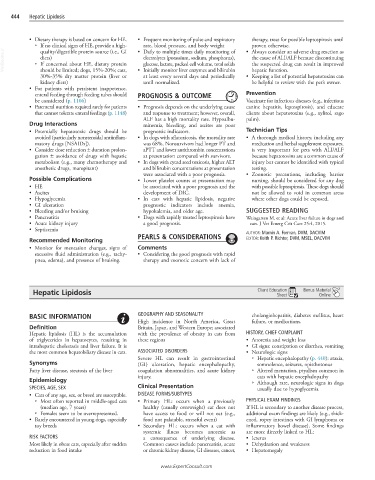Page 910 - Cote clinical veterinary advisor dogs and cats 4th
P. 910
444 Hepatic Lipidosis
• Dietary therapy is based on concern for HE. • Frequent monitoring of pulse and respiratory therapy, treat for possible leptospirosis until
○ If no clinical signs of HE, provide a high- • Daily to multiple times daily monitoring of • Always consider an adverse drug reaction as
rate, blood pressure, and body weight
proven otherwise.
VetBooks.ir ○ If concerned about HE, dietary protein electrolytes (potassium, sodium, phosphorus), the cause of ALI/ALF because discontinuing
quality/digestible protein source (i.e., GI
diets)
glucose, lactate, packed cell volume, total solids
the suspected drug can result in improved
should be limited; dogs, 15%-20%; cats,
hepatic function.
at least every several days and periodically
30%-35% dry matter protein (liver or • Initially monitor liver enzymes and bilirubin • Keeping a list of potential hepatotoxins can
kidney diets) until normalized. be helpful to review with the pet’s owner.
• For patients with persistent inappetence,
enteral feeding through feeding tubes should PROGNOSIS & OUTCOME Prevention
be considered (p. 1106) Vaccinate for infectious diseases (e.g., infectious
• Parenteral nutrition required rarely for patients • Prognosis depends on the underlying cause canine hepatitis, leptospirosis), and educate
that cannot tolerate enteral feedings (p. 1148) and response to treatment; however, overall, clients about hepatotoxins (e.g., xylitol, sago
ALF has a high mortality rate. Hypoalbu- palm).
Drug Interactions minemia, bleeding, and ascites are poor
• Potentially hepatotoxic drugs should be prognostic indicators. Technician Tips
avoided (particularly nonsteroidal antiinflam- • In dogs with aflatoxicosis, the mortality rate • A thorough medical history, including any
matory drugs [NSAIDs]). was 68%. Nonsurvivors had longer PT and medication and herbal supplement exposures,
• Consider dose reduction ± duration prolon- aPTT and lower antithrombin concentrations is very important for pets with ALI/ALF
gation ± avoidance of drugs with hepatic at presentation compared with survivors. because hepatotoxins are a common cause of
metabolism (e.g., many chemotherapy and • In dogs with cycad seed toxicosis, higher ALT injury but cannot be identified with typical
anesthetic drugs, maropitant) and bilirubin concentrations at presentation testing.
were associated with a poor prognosis. • Zoonotic precautions, including barrier
Possible Complications • Lower platelet counts at presentation may nursing, should be considered for any dog
• HE be associated with a poor prognosis and the with possible leptospirosis. These dogs should
• Ascites development of DIC. not be allowed to void in common areas
• Hypoglycemia • In cats with hepatic lipidosis, negative where other dogs could be exposed.
• GI ulceration prognostic indicators include anemia,
• Bleeding and/or bruising hypokalemia, and older age. SUGGESTED READING
• Pancreatitis • Dogs with rapidly treated leptospirosis have Weingarten M, et al: Acute liver failure in dogs and
• Acute kidney injury a good prognosis. cats. J Vet Emerg Crit Care 25:4, 2015.
• Septicemia AUTHOR: Marnin A. Forman, DVM, DACVIM
PEARLS & CONSIDERATIONS
Recommended Monitoring EDITOR: Keith P. Richter, DVM, MSEL, DACVIM
• Monitor for mentation changes, signs of Comments
excessive fluid administration (e.g., tachy- • Considering the good prognosis with rapid
pnea, edema), and presence of bruising. therapy and zoonotic concern with lack of
Hepatic Lipidosis Client Education Bonus Material
Sheet
Online
BASIC INFORMATION GEOGRAPHY AND SEASONALITY cholangiohepatitis, diabetes mellitus, heart
High incidence in North America, Great failure, or medications.
Definition Britain, Japan, and Western Europe; associated
Hepatic lipidosis (HL) is the accumulation with the prevalence of obesity in cats from HISTORY, CHIEF COMPLAINT
of triglycerides in hepatocytes, resulting in these regions • Anorexia and weight loss
intrahepatic cholestasis and liver failure. It is • GI signs: constipation or diarrhea, vomiting
the most common hepatobiliary disease in cats. ASSOCIATED DISORDERS • Neurologic signs
Severe HL can result in gastrointestinal ○ Hepatic encephalopathy (p. 440): ataxia,
Synonyms (GI) ulceration, hepatic encephalopathy, somnolence, seizures, opisthotonus
Fatty liver disease, steatosis of the liver coagulation abnormalities, and acute kidney ○ Altered mentation, ptyalism common in
injury. cats with hepatic encephalopathy
Epidemiology ○ Although rare, neurologic signs in dogs
SPECIES, AGE, SEX Clinical Presentation usually due to hypoglycemia
• Cats of any age, sex, or breed are susceptible. DISEASE FORMS/SUBTYPES
○ Most often reported in middle-aged cats • Primary HL: occurs when a previously PHYSICAL EXAM FINDINGS
(median age, 7 years) healthy (usually overweight) cat does not If HL is secondary to another disease process,
○ Females seem to be overrepresented. have access to food or will not eat (e.g., additional exam findings are likely (e.g., thick-
• Rarely encountered in young dogs, especially food not palatable, stressful event) ened, ropey intestines with GI lymphoma or
toy breeds • Secondary HL: occurs when a cat with inflammatory bowel disease). Some findings
systemic illness becomes anorexic as are more directly linked to HL:
RISK FACTORS a consequence of underlying disease. • Icterus
Most likely in obese cats, especially after sudden Common causes include pancreatitis, acute • Dehydration and weakness
reduction in food intake or chronic kidney disease, GI diseases, cancer, • Hepatomegaly
www.ExpertConsult.com

